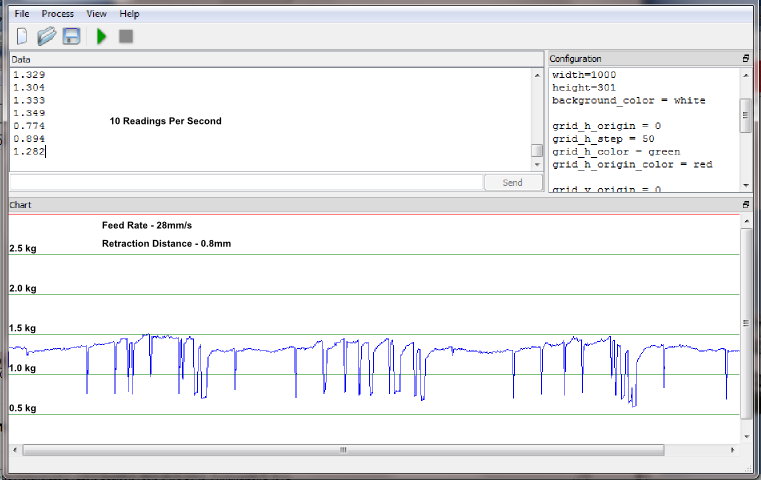Yep, my 3d printer now has a filament force sensor. It works great and it looks awesome. I’m just at the end of a second full day of testing and the installation has not caused any print quality issues using the same g-code as before.
My 3d printer is tied up doing production runs so not yet had the opportunity to study cause and effect with different Skeinforge settings. Basically I’ve been studying live graphs from the production runs; checking for consistency between print jobs and during print runs. The graph below is a 100 second snapshot of a production run I was doing.
3D Printer Extruder Force Sensor Graph Sample
From the graph it is easy to tell when the printer is printing and when it is not. The drops are the retractions and you can see that the nozzle loses pressure after each retraction. The retractions also show a period of travel without printing, and the longer the travel – the more pressure is lost. Also, a bunch of retractions together shows a decline in nozzle pressure with each retraction.
The pressure sensor is preloaded with 200g of force so that the retractions can be absorbed by the sensor without bottoming out. This has not been accounted for in the graph and so 200g needs to be taken off the force sensor graph readings in this case.
By looking at the graph I would deduct that my retraction setting is not long enough. Even after deducing the 200g pre-load, there is still a round 500g of force applied by the extruder.
Extruder Force Sensor – The Next Step
There is plenty of room for improvement on my 3d prints and I’ll be looking at the graphs to see if the readings can help identify what settings needs to be changed to get the best print quality. Also I’ll be testing the force sensor on printing simple shapes to better judge sensor reading consistency.
How do I get one of these sensor thingies?
I don’t want to reveal the set-up until I’ve got all the support documentation ready to publish. This is because I need the time to focus on the documentation that will allow others to replicate the sensor kit as easily as possible. If I reveal my set-up now, many people will try to build there own sensor kit and I could be bogged down with providing support.
Due to the low investment cost of the hardware and the potential it has for testing 3d printer extruders and hot ends, the force sensor gauge is likely to be very popular. So I’ll be looking to get the airtripper extruder filament force sensor properly backed up with good support documentation.
[bodyadsrich1l]
If you would like to speculate how the force sensor works and how it is fitted, use the comment section below.


I was working on that looooong time ago. How does your system look like? I used two load cells http://www.flickr.com/photos/prusajr/5844014968/in/photostream
With 3mm filament I was reading about 10kg force 🙂
Yeah, I wondered if this had been attempted before, I think 10kg of force would likely break something on my printer 🙂 We probably don’t need half that much force today. I may be wrong.
I’m using a 5kg load cell on a bowden cable type extruder. Basically, anybody that is using the Airtripper style extruder set-up would be able to easily get this new kit in place. It would just be an extruder upgrade, but takes up a little more room.
My focus is with the bowden extruder set up because this is where the sensor data will be of more use for g-code set-up. I think most bowden users will be glad of a little feedback if it will help get the best out of their bowden extruder system.
Mark